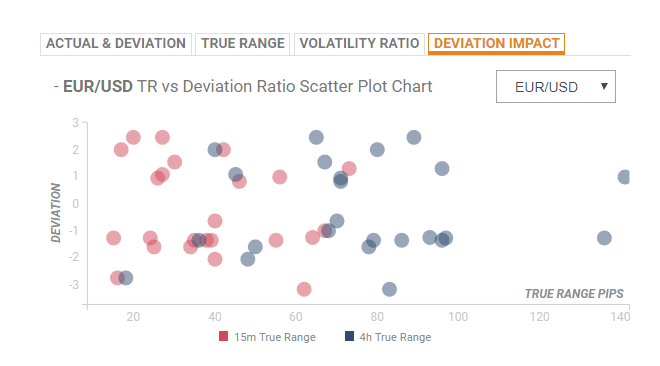US October CPI Overview
Today's US economic docket highlights the release of the latest consumer inflation figures, due for release later during the early North-American session at 1330GMT. The headline CPI is expected to have risen by 0.3% m/m in October and the yearly rate is anticipated to accelerate to 2.5% y/y, up from the previous month's 2.3%.
Meanwhile, core CPI, which excludes volatile food and energy prices, is forecasted to edge higher by 0.2% on a monthly basis, a slightly faster pace than 0.1% recorded in September, and hold steady at 2.3% y/y rate during the reported month.
Deviation impact on EUR/USD
Readers can find FX Street's proprietary deviation impact map of the event below and as observed, the reaction in case of a relative deviation of +0.98 to -1.25 in the core CPI print is likely to be in the range of 24-26 pips during the first 15-minutes and could stretch to around 68-71 pips in the following 4-hours.

How could it affect EUR/USD?
Yohay Elam, FXStreet's own Analyst explains, “the pair failed in its first attempt to reconquer 1.1300. The level is not only a round number but also a critical line after working as a double-bottom. The Relative Strength Index (RSI) is out of oversold territory (below 30), but Momentum still points to the downside.”
“Support awaits at 1.1260 which temporarily capped the EUR/USD on Tuesday. 1.1215 is the 17-month low. Further down, we are back to levels last seen in 2017: 1.1110 and 1.1000 are notable,” he added further.
Key Notes
• US Inflation Preview: Stability in core CPI, temporary gain in consumer index
• EUR/USD Forecast: The Good, the Bad, and the Ugly, still looking vulnerable
• EUR/USD Technical Analysis: Spot looks vulnerable and still targets 1.1188
About the US CPI
The Consumer Price Index released by the US Bureau of Labor Statistics is a measure of price movements by the comparison between the retail prices of a representative shopping basket of goods and services. The purchasing power of USD is dragged down by inflation. The CPI is a key indicator to measure inflation and changes in purchasing trends. Generally speaking, a high reading is seen as positive (or bullish) for the USD, while a low reading is seen as negative (or Bearish).
Information on these pages contains forward-looking statements that involve risks and uncertainties. Markets and instruments profiled on this page are for informational purposes only and should not in any way come across as a recommendation to buy or sell in these assets. You should do your own thorough research before making any investment decisions. FXStreet does not in any way guarantee that this information is free from mistakes, errors, or material misstatements. It also does not guarantee that this information is of a timely nature. Investing in Open Markets involves a great deal of risk, including the loss of all or a portion of your investment, as well as emotional distress. All risks, losses and costs associated with investing, including total loss of principal, are your responsibility. The views and opinions expressed in this article are those of the authors and do not necessarily reflect the official policy or position of FXStreet nor its advertisers. The author will not be held responsible for information that is found at the end of links posted on this page.
If not otherwise explicitly mentioned in the body of the article, at the time of writing, the author has no position in any stock mentioned in this article and no business relationship with any company mentioned. The author has not received compensation for writing this article, other than from FXStreet.
FXStreet and the author do not provide personalized recommendations. The author makes no representations as to the accuracy, completeness, or suitability of this information. FXStreet and the author will not be liable for any errors, omissions or any losses, injuries or damages arising from this information and its display or use. Errors and omissions excepted.
The author and FXStreet are not registered investment advisors and nothing in this article is intended to be investment advice.
Recommended content
Editors’ Picks
EUR/USD edges lower toward 1.0700 post-US PCE

EUR/USD stays under modest bearish pressure but manages to hold above 1.0700 in the American session on Friday. The US Dollar (USD) gathers strength against its rivals after the stronger-than-forecast PCE inflation data, not allowing the pair to gain traction.
GBP/USD retreats to 1.2500 on renewed USD strength

GBP/USD lost its traction and turned negative on the day near 1.2500. Following the stronger-than-expected PCE inflation readings from the US, the USD stays resilient and makes it difficult for the pair to gather recovery momentum.
Gold struggles to hold above $2,350 following US inflation

Gold turned south and declined toward $2,340, erasing a large portion of its daily gains, as the USD benefited from PCE inflation data. The benchmark 10-year US yield, however, stays in negative territory and helps XAU/USD limit its losses.
Bitcoin Weekly Forecast: BTC’s next breakout could propel it to $80,000 Premium

Bitcoin’s recent price consolidation could be nearing its end as technical indicators and on-chain metrics suggest a potential upward breakout. However, this move would not be straightforward and could punish impatient investors.
Week ahead – Hawkish risk as Fed and NFP on tap, Eurozone data eyed too

Fed meets on Wednesday as US inflation stays elevated. Will Friday’s jobs report bring relief or more angst for the markets? Eurozone flash GDP and CPI numbers in focus for the Euro.